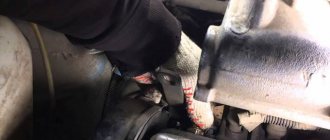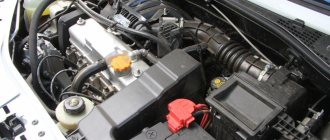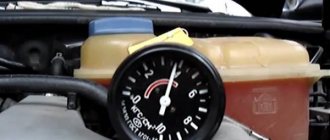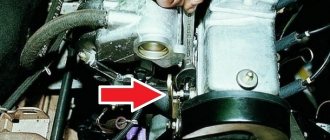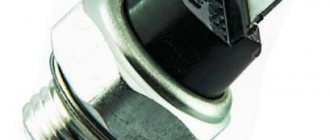The ODM (Oil Pressure Sensor) on the Lada Grant, like on any other car, is designed to signal the driver about the oil pressure in the engine. If it falls, the sensor will report this to the BC and the corresponding information will be visible on the dashboard display or on-board computer.
But sometimes it happens that the oil pressure warning light comes on, but the oil level and pressure are normal, and the reason is a malfunction of the oil pressure sensor.
➤ Self-replacement of the oil pressure sensor on Lada Vesta
Owners of a Lada Vesta with a VAZ 21179 (1.8 l) engine are faced with the fact that the oil pressure indicator does not go out for a long time when starting the engine. Or the diode does not light up at all.
Many car enthusiasts panic about this, saying they need to change the oil, undergo maintenance, etc. Do not rush to go to extremes; most likely the cause is the emergency oil pressure sensor (hereinafter referred to as EBP). The process of self-replacement is not complicated, but requires care on the part of the repairman.
Procedure for replacing the oil pressure sensor on a Lada Vesta yourself
- Turn off the engine;
- Open the hood;
- Wait until the engine cools down so as not to damage the skin of your hands;
- Remove the block with wires from the DBP, which is located on the left in the direction of travel, behind the oil filler neck;
- Using the key “19”, unscrew the old controller;
- Wipe the seat with a rag;
- Screw in the new controller;
- Put on the block with wires;
- Start the engine and check the oil pressure.
Where is DBP located?
Lada Vesta, as well as X-Ray, is equipped with two modifications of gasoline engines:
- 8 liter 16 valve (122 hp);
- 6 liter 8 valve (109 hp).
Both versions have the same oil pump pre-installed. Obviously, in engines with a large volume, the pump wears out faster, since according to its technical characteristics it is not designed for heavy loads.
Engine oil volume is 1.6 liters. 3.4 liters, in the version with a 16-valve mechanism - 4.5 liters.
- The standard location of the DBP is on the left in the direction of travel of the car, behind the oil filler neck.
| Symptoms of a problem | Causes |
| On-board computer system error P0523 on the dashboard | Loose contact of DBP terminals |
| After starting the engine, the emergency oil pressure lamp stays on for a long time. | Low engine pressure |
| When starting the engine, the emergency engine oil pressure indicator on the instrument panel does not light up. | The electrical circuit of the on-board power supply is damaged |
Replacing the emergency oil pressure sensor with your own hands
Preparation of the workplace, necessary tools:
- Key, head on “19”;
- Rags;
- Additional lighting (optional);
- New pressure controller.
- Regulations:
- We place the car on a flat area;
- We turn off the engine;
- Open the hood;
- We wait until the power unit cools down so as not to damage the skin of the hands;
- Remove the block with wires from the DBP;
- Using the key “19” we unscrew the controller from its regular place;
- We carry out troubleshooting of the seat;
- We screw in the new controller;
- We put on the block with wires;
- We start the engine and check the serviceability of the sensor.
Review of Manufacturer Prices
| Name / catalog article | Price in rubles |
| 11180382901003 | From 650 |
| Fram 2656534154(1) (Lada Vesta 1.6) | From 500 – 550 |
| *prices are as of 05/01/2019 |
Conclusion
Replacing the oil pressure sensor in a Lada Vesta car yourself is not difficult. The task is within the power of every car enthusiast. If any difficulties arise, contact service station specialists for help. Follow safety precautions and do not start work “hot”. When purchasing spare parts, carefully check the catalog numbers with the data specified in the instruction manual.
Reviews
| № | Positive |
| 1 | Petr (autodrome): there are no complaints about the functionality of the DBP, they work in normal mode, the mileage is 34,500 km. |
| 2 | Vyacheslav (autotopic): I tightened the fastening of the terminal on the DAD once, did not contact the service center, managed it on my own. |
| 3 | Victor (Autoreview): the emergency warning diode goes out within 2 seconds after the engine starts. The workshop assured that this is the norm. |
| 4 | Kirill (Avtoria): the car is four years old, mileage 55,000 km, no repairs. I regularly visit service stations and fill them with high-quality fuel and oils. |
| 5 | Alexander (Drom): there have been no critical comments on the operation of the machine for three years; minor breakdowns were eliminated on my own. |
| 6 | Stanislav (Driving): mileage 60,000 km, no rude comments. |
| 7 | Stepanovich (“5th wheel”): my positive review of the Lada Vesta, the car is good, the build quality is above average. For domestic transport it is quite tolerable. |
| Negative | |
| 8 | Vitaly (autotopic): I replaced the DBP for the first time in the third year of the car’s life, fortunately the repair was free of charge, under warranty. |
| 9 | Mikhail (otzovik.net): I heard about the problem with the 1.8 liter oil pump, it is weak for such a volume. |
| 10 | Stanislav (ProAvto): the car constantly breaks down, something breaks, it doesn’t work properly. |
Video - Sensor malfunction
Source: https://remont-avtovaz.ru/lada-vesta-oshibka-r0523-i-davlenie-masla-v-dvigatele/
Advice for car enthusiasts without car repair experience
Oil pressure sensor
What to do if trouble happens on the road? The most logical course of action is to check the main causes of low oil pressure as they become more expensive.
Lack of oil in the engine sump
Where can it go? Worn out engines consume oil during operation, loose gaskets cause oil to leak onto the ground, a faulty turbine or damaged housing will lead to the release of oil under pressure. Having opened the hood, inspect the engine compartment and the ground under the car - the oil leaves greasy traces, and it is impossible not to notice them.
Each internal combustion engine has a special dipstick that is used to check the oil level.
The dipstick ring is painted in a bright color
The oil level should be within the marks on the dipstick
If the oil level is low, be sure to top it up. Top up in small portions, monitoring the level.
The place where you need to fill the oil is indicated by the already familiar “oil can” symbol.
Sensor or wiring fault
Over time, the connectors oxidize, and during repairs, the wires get caught and come off. You need to remove the connectors and inspect them for oxidation. The oxide on the connectors is usually green or dark brown. This deposit should be thoroughly cleaned with a file or sandpaper.
A coating of dirt and oxides prevents the passage of electric current
Very often, troubles are hidden in the sensors, but without checking the oil pressure with a pressure gauge, this will not be clear. You can visually assess the condition of the sensor - whether there is any damage, whether the connectors are loose, whether the wire is attached to it at all.
The oil pressure sensor is usually located next to the oil filter or on the cylinder head. Depending on the car model, the sensor can be located in completely different places. To determine exactly where it is located, you need to study the car’s operation and repair manual, or ask a car mechanic.
The only way to check the functionality of the sensor is to replace it with a known good one.
Wrong oil
If too thin oil is poured into a worn engine, the pump will not be able to create the required pressure. Therefore, it is better to use oils prescribed by the manufacturer. Contact specialized oil change services. Employees of these institutions have catalogs of oils recommended for various brands of cars.
In worn-out engines, condensation collects in the oil or coolant gets into the oil. This leads to the appearance of an air-oil emulsion, which reduces the pressure in the oil lines (air is compressed, unlike oil). The emulsion is clearly visible if you open the oil filler neck.
Yellow-brown foam on the oil filler neck is a sign of foreign liquids getting into the oil
If there is a lot of emulsion, you need to change the oil and eliminate the cause of liquid getting into the oil. If it is condensation, you should periodically “walk” the car over long distances. If it is coolant, replace the cylinder head gasket and test the engine parts for leaks.
Clogged or faulty oil filter
If you changed the oil a long time ago and added oil from different manufacturers, sediments and resins can tightly clog the surface of the filter element. If a problem occurs after changing the oil, most likely you were given a filter that does not fit this car model. Car filters are equipped with a special valve that retains some of the oil in the filter. An incorrect valve design will “lock” the oil in the filter and prevent it from moving through the channels. Changing the oil and filters should eliminate these causes.
Other reasons require special tools for diagnosis, and troubleshooting requires a garage and repair skills. Therefore, it is best to entrust repairs to specialists from a service station.
A clogged or faulty oil filter can cause scuffing and engine damage.
It is important to know that the indicator lamp will not light up just like that, there is a malfunction here, so it is worth fixing them as soon as possible. There may be several reasons for the signal, and all are not covered in this article. Do not delay in identifying breakdowns, because they can lead to much more complex consequences. Remember that motor oil plays a very important role in the implementation of motor processes that occur inside a car engine
Monitoring the oil level is the primary task of every driver.
https://youtube.com/watch?v=WR3iI17gLtI
Replacing the oil pressure sensor on Grant 16-valve
The emergency oil pressure sensor is installed on 16-valve Lada Granta engines on the right side, and is located directly on the cylinder head. To make it clear where to look for it, below is its visual location in the photo.
To make it even clearer, there is one green wire going to it.
So, the emergency oil pressure sensor itself on Grant is needed in order to signal a sound signal and the warning lamp on the instrument panel during a drop in pressure in the system.
If suddenly, while driving or idling, the warning light comes on, you must immediately turn off the engine.
You can start the engine in the future only after determining the reason for the operation of this alarm.
If the cause is a failure of the sensor itself, then everything can be fixed here as quickly and inexpensively as possible. We buy a new one and install it in its original place, replacing the faulty one. To perform this procedure, you must use the following tool:
- Ratchet handle or crank
- Extension
- 21 socket or similar spark plug
Procedure for replacing the oil pressure sensor on a 16-valve Grant
The first step is to disconnect the power wire from the sensor, as shown in the photo below, after pressing the block on both sides, thereby releasing it from the latches.
Then use a 21 mm socket to unscrew it:
When it spins freely, you can finally turn it out by hand.
As you can see, everything is done elementary and simple. Now we take a new sensor and make a replacement, installing it in its original place to replace the failed one. The price of a new part is only 118 rubles for AvtoVAZ production, and even cheaper, about 100 rubles for the Pekar brand.
The sensor must be tightened with a certain torque, which ranges from 24 to 27 Nm.
Source: https://zarulemvaz.ru/zamena-datchika-davleniya-masla-na-grante-16-klapanov/
Engine of the old modification 11183
Engine 11183 is installed on the Standard Grant. It migrated here from the Kalina car. The unpretentious and time-tested engine is quite reliable and does not raise any questions. Its power is quite enough for city driving. Such an engine is less suitable for the track, but Grant will have quite good luck. This engine also has advantages - its elasticity. Unlike the Kalina engine 1.4l 16kl. from the very bottom he begins to accelerate the car well.
This important sensor is located behind the engine air filter. It is also called an air flow meter. Its purpose is to estimate the amount of air entering the car engine. Based on the information received from the sensor, the electronic control unit (ECU) calculates the required amount of fuel to maintain the stoichiometric fuel-to-air ratio for the given engine operating conditions.
Replacing the oil pressure sensor Lada Granta
An oil pressure sensor, or simply DDM, is a signaling device for the driver that displays the level of oil pressure in the engine. It usually turns on when the level drops noticeably. However, this element may also fail.
Replacing the Grant oil pressure sensor is a process that does not require phenomenal knowledge. You need to have a few tools and instructions on hand.
The DDM consists of three elements:
- Protective housing;
- Measuring membrane;
- Transmitting element.
Operating principle of DDM
The operating system is simple - under oil pressure, the measuring membrane changes position and, as a result, the contacts open or close. When the liquid level drops, the membrane falls, thereby disconnecting the contacts.
After which a signal is triggered and displayed on the dashboard. If the oil pressure sensor on a Lada Granta fails, but the oil level is normal and the entire system, after testing, turns out to be operational, then it is recommended to check the meter itself.
Advice! If you haven’t looked under the hood of your car before and haven’t done at least a little repair and technical work, then you shouldn’t move on to the next stage. Despite the fact that the replacement process is very simple, you can damage the car due to lack of experience.
Location and replacement of the oil pressure sensor on Grant
If you have problems with the DDM or its location ( where the oil pressure sensor is located on the grant ), then the initial task is to find it. In order to get to it, you will need: a ratchet handle, a 21mm socket or equivalent, and a pressure gauge (optional).
The first step is preparation for work. Remove the plastic panel from the engine and on the right side find the required Grant 8 valve oil pressure sensor. It is screwed into the head of the cylinder block (cylinder block). Firmly squeeze the clamps and remove the block. We unscrew the sensor using tools (spanner or open-end wrench 22).
How DDM works
The oil sensor is simple to operate: the measuring membrane changes its position under the influence of pressure, which leads to the opening or closing of the contacts. When the oil level drops, the membrane falls off and the contacts become disconnected. This triggers a signal displayed on the instrument panel.
It happens that the oil level is normal, but the oil pressure sensor on the Lada Granta still does not work correctly. In such a situation, it is recommended to find and check the performance of the meter itself.
Without proper experience in working with technical equipment, you should not climb under the hood, as there is a possibility of damaging the car.
Replacing the oil pressure sensor on Lada Kalina
Most car owners do not fully understand what the oil pressure sensor installed on the Lada Kalina is. After all, as practice shows, car owners do not often look at the special booklet attached to the car when purchasing it, so often many do not even suspect what this or that symbol on the dashboard indicates.
Most often, owners of a Lada Kalina with an 8-valve engine have to get acquainted with the DDM after the pressure indicator on the panel lights up and does not go out for a long time. This, of course, should alert any driver.
Having discovered a burning indicator, one part of car owners will rush to seek help from a service station, while the other decides to solve the problem themselves. Let's try to figure out why the indicator lights up and how
The oil pressure sensor on Kalina is being replaced step by step.
However, before we begin to consider the main issue, we should understand what exactly caused the indicator to light up. After all, experts say that the light actually indicates a critical oil level in the system.
But, on top of everything else, the indicator may not go out for a long time even if the sensor itself has failed.
Do not start work without finding out the reason for the indicator light. This can greatly worsen the technical condition of the car and lead to more serious problems during operation.
What elements does DDM consist of?
First of all, you need to figure out what components the sensor consists of.
So, the device in question includes the following elements:
- protective housing;
- measuring membrane;
- transmission mechanism.
Having understood the components of the device, it will be much easier to understand the principle of its operation.
What is the work of DDM based on?
After turning on the ignition, the membrane will begin to bend, occupying a certain position. Exactly what position the membrane will take depends on the pressure currently available inside the oil system. Occupying the desired position, the membrane closes the electronic contact or, on the contrary, opens it.
Before you start checking the operation of the sensor, you must make sure that the oil filter and oil level are normal. It is equally important to analyze whether there are any streaks on the surface of the engine. If the above symptoms are not detected, you can begin to check the serviceability of the pressure sensor.
Lada Kalina or Lada Granta: which is better according to the owners
Step-by-step verification
Pressure-related devices are checked using a special pressure gauge. The components must be installed in place of the DDM and the car engine must be started.
If the pressure gauge displays 0.65 kgf/cm2 at idle, we can safely say that the sensor is working normally and the pressure is within normal limits.
If the device displays a reduced reading, you will have to replace the oil pressure sensor.
You can check the serviceability of the DDM in another way, that is, without the help of a pressure gauge. After all, it may happen that the indicator lights up while driving. In such circumstances, car owners need to do the following:
- Initially, the sensor is unscrewed from the “socket”;
- next you need to start spinning the starter without starting the engine;
- if oil begins to appear from the “socket” when the starter rotates, this factor will indicate a sensor malfunction.
Under no circumstances should you operate a car without replacing a faulty DDM. After all, all components in the car must work properly; this is important from a safety point of view.
Self-replacement
Replacing a faulty oil pressure sensor yourself is quite simple, following the step-by-step instructions:
- To work, you need to prepare a car key for 21.
- First of all, carefully remove the protective cover from the engine.
- Next, you should pay attention to the reverse side of the engine, since the sensor is screwed into the cylinder head “socket” located on the right.
- By pressing the latches, the holding pads must be disconnected from the pad.
- Unscrew the sensor from the “socket” using a key.
- A new sensor is installed in place of the old, failed one. Before installation, carefully wipe the surface of the “nest” with a clean cloth.
- At the last stage, check the reliability of all installed components, fix the protective cover and check whether the problem has been corrected.
If after starting the engine the indicator goes out after a few seconds, this fact will confirm that the light came on precisely because of a malfunction of the oil pressure sensor.
As you can understand, the process of replacing the DDM is quite simple and understandable, so any Lada Kalina car owner can handle such work. If difficulties arise during the replacement process, you should watch the video instructions prepared by professionals at any time.
Source: https://ladaautos.ru/lada-kalina/zamena-datchika-davleniya-masla-na-lade-kalina.html
Recommendations
Comments 12
Priora oil pressure sensor
That's it, guys, the problem is solved. There was condensation in the oil receiver, and this condensate froze. We drained the oil, removed the filler, warmed up the oil receiver, filled in oil, started the engine, heated the engine to 80 and drained the oil, then poured in new oil. Now everything seems to be fine.
Drain the oil, my sump and change the oil receiver, a friend did this on a viburnum and the machine came to life.
I don’t think it’s anything serious, maybe the oil is frozen. Another option is to check the wire that goes to the sensor with a tester; if the light does not light, it means there is an open circuit, this happens in cold weather
I had this happen with a couple of Kalinovodovs as well. Condensation. It appears if you go on short trips in winter. Then it freezes in the car along with the oil in severe frost. I warmed up the pan and changed the oil. I switched to 5v40 Mobile. Before this, the owner supposedly had zero .Thank God this didn’t happen again!
How did this happen? was it running or was the car parked for a long time?
Yesterday I had this, the oil was frozen, I started it 3 times, the light didn’t go out, I dragged it to the garage, I warmed it up with a hairdryer, then I started it right away and it went out... Toyota 5-40 oil drove 1000 km... before that I used Lukoil semi-synthetic at -35 there were no problems. But then it froze
It was -30 outside, probably the oil pickup was frozen.
Unscrew the sensor. and if the oil presses, look for the reason. Possibly with wiring jamb.
I measured the pressure with a pressure gauge - there is no pressure at all. I'll take the pan off and have a look.
oo. this is not ice. at best, the oil pump is a mess.
Is the pan jammed in the area of the oil receiver?
no, it's not jammed. I measured the pressure with a mechanical monometer - pressure 0.
About LADA car sensors and engine management system
12 October 2015 LadaOnline 159 004
Various sensors are responsible for the operation of all systems of a modern car. They take readings and transmit them to the electronic engine control unit (ECU). If the sensor malfunctions, an error is stored in the memory, and in some cases a Check Engine error appears on the instrument panel.
Where are the sensors located?
All modern Lada cars (Granta, Kalina, Priora, Vesta, Largus, Niva or Lada XRAY) are equipped with domestic VAZ engines. The location of the sensors on these motors is the same:
Elements of the electronic engine control system of the VAZ 11186/11189: 1* – controller; 2* – crankshaft position sensor; 3* – control oxygen concentration sensor; 4* – diagnostic block; 5* – diagnostic oxygen concentration sensor; 6 – throttle control unit; 7* – vehicle speed sensor; 8* – adsorber purge valve; 9* – gas pedal module; 10* – brake signal switch; 11* – clutch pedal position sensor; 12 – battery; 13 – mass air flow sensor; 14 – coolant temperature sensor; 15 – ignition coil; 16 – knock sensor; 17 – spark plugs; 18* – nozzles. *The item is not visible in the photo.
Camshaft position sensor (phase sensor)
This element is responsible for generating a signal, based on which the ECU is able to determine the angular position of the camshaft at any time period. On eight-valve AvtoVAZ engines, these devices are located at the cylinder head on the left, on sixteen-valve engines - in front and on the right of the engine.
If they break down, the system switches to operating in backup mode, which affects the stability of the engine. Repair of this sensor is impossible; any failure will require replacing the sensor with a new one.
The most common signs of DPRV failure include:
- unstable operation of the motor;
- problems starting the engine;
- the engine often stalls when the gas pedal is released;
- exceeding fuel consumption standards.
When diagnosing the device, the following errors are detected:
- P0340 – element is faulty;
- P0342 – low signal level;
- P0343 – the signal level supplied by the element is too high.
Absolute pressure and air temperature sensors
These sensors are combined into one housing and installed on the receivers of the intake module; the most modern AvtoVAZ engines are equipped with them.
DBP differs in the output signal voltage in the range of 0.15..4.6 V, this voltage depends on the pressure level inside the intake pipe. The information it sends helps the ECU calculate the amount of air received by the intake pipe during one cycle.
A breakdown of the device circuit leads to an error code being entered into the system memory, and then the alarm turns on. After this, the control system calculates the air received based on the crankshaft speed, as well as based on the throttle valve opening angle.
The sensitive component of the DTV is the inlet pipe thermistor. The output signal voltage of the device connected to the computer will be approximately 0.3..4.9 V, it depends on the temperature of the air passing through the specified element. When a DTV failure is detected, the control system performs actions similar to its actions in the event of a DBP failure, replacing the readings of the described device with fixed temperature values.
Error 0523 Lada Granta - Autognostics
The ODM (Oil Pressure Sensor) on the Lada Grant, like on any other car, is designed to signal the driver about the oil pressure in the engine.
If it falls, the sensor will report this to the BC and the corresponding information will be visible on the dashboard display or on-board computer.
But sometimes it happens that the oil pressure warning light comes on, but the oil level and pressure are normal, and the reason is a malfunction of the oil pressure sensor.
Operating principle of the oil pressure sensor and checking it
The operating principle of the DDM is quite simple - depending on the oil pressure, the measuring membrane inside the sensor bends under the oil pressure and closes and opens the contacts. If the engine oil level drops, the contacts open accordingly and the oil pressure warning light comes on.
Before checking the sensor, make sure that:
If everything is in order with the oil level and filter, you need to check the sensor circuit and itself.
- We check the circuit from the sensor to the warning lamp. Disconnect the terminal from the sensor and lean it against ground. If the circuit is working properly, the oil pressure lamp should go out. If not, there may be a break in the circuit somewhere.
- If after removing the DDM it is in oil, then it is faulty and requires replacement; if the sensor is dry, the reason is in the oil filter, oil level or oil pump.
- You can also check the oil pressure in the engine using a pressure gauge. To do this, unscrew the sensor and screw in the pressure gauge. Start the engine and at idle speed the pressure gauge should show 0.65 kgf/cm2 or more, which means the pump and everything else is fine. The sensor just needs to be replaced.
If your vehicle is equipped with an on-board computer, a P0523 (Oil Pressure Sensor High Voltage) error will appear if the ODM malfunctions. This error indicates that the sensor needs to be replaced.
Where is the sensor located and its part number
The DDM is located on the right side of the engine and is screwed into the cylinder head. To replace it, you will need to remove the plastic decorative cover, after which the sensor will be immediately visible. Replacing the sensor itself is very simple, unscrew the old one and install the new one, no additional actions need to be performed.
The article number of the original oil pressure sensor is 11180-3829010-00 . Its cost may vary in different regions, but on average it ranges from 120 to 160 rubles.
Replacing the sensor yourself
- We remove the decorative plastic protection and put it aside so that it does not interfere
- Carefully squeeze the clamps and remove the block from the sensor
- Using a spanner or open-end wrench set to “21”, unscrew the sensor.
- Now we will examine it and diagnose it according to the points that we described above.
We screw in the new sensor, connect the wire block and start the engine.
If the oil pressure light goes out, then the problem was in the sensor; if not, then you need to look for the cause further.
Source: https://avtognostika.ru/lada/oshibka-0523-lada-granta
Is it dangerous or is it safe to drive like this?
Often on some forums, I read: “okay, it’s no big deal, you can drive like that, well, just think, it caught fire, then went out, everything seems to be fine”!
Guys, this is a very erroneous opinion, if only simply because after starting the engine runs almost “dry” for several seconds. At this time, there is simply catastrophic wear of parts. Especially in the winter, cold period, the oil is already cold, plus there is no engine lubrication.
With this approach, the capital of the engine is not far away. And guys, a filter costs a penny, a good one costs from 300 to 500 rubles, well, don’t skimp, overpay 100 - 200 rubles, don’t buy the “crap” option, but you’ll ride calmly, as they say - no problems.
I think my message has reached you, now we are watching the video version of the article.
This is where I end, I think my article was useful to you.
(11 votes, average: 4.82 out of 5)

